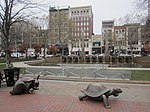Back Bay station

Back Bay Station (also signed as Back Bay · South End) is an intermodal passenger station in Boston, Massachusetts. It is located just south of Copley Square in Boston's Back Bay and South End neighborhoods, it serves MBTA Commuter Rail and MBTA subway routes, and also serves as a secondary Amtrak intercity rail station for Boston. The present building, designed by Kallmann McKinnell & Wood, opened in 1987. It replaced the New Haven Railroad's older Back Bay station – which opened in 1928 as a replacement for an 1899-built station – as well as the New York Central's Huntington Avenue and Trinity Place stations which had been demolished in 1964. Although South Station is Boston's primary rail hub, Back Bay maintains high traffic levels due to its location in the Back Bay neighborhood near the Prudential Center development and its access to important Northeast Corridor services. All Amtrak Acela Express and Northeast Regional trains running to and from South Station stop at Back Bay, as does the Boston section of the Lake Shore Limited. Four MBTA Commuter Rail routes – the Providence/Stoughton Line, Franklin Line, Needham Line, and Framingham/Worcester Line – also stop at Back Bay, as do the Orange Line subway and several local MBTA bus routes. It is the third-busiest MBTA Commuter Rail station (after North Station and South Station) and the sixth-busiest MBTA subway station.
Excerpt from the Wikipedia article Back Bay station (License: CC BY-SA 3.0, Authors, Images).Back Bay station
Dartmouth Street, Boston South End
Geographical coordinates (GPS) Address Website External links Nearby Places Show on map
Geographical coordinates (GPS)
| Latitude | Longitude |
|---|---|
| N 42.3473 ° | E -71.0755 ° |
Address
Dartmouth Street 145
02116 Boston, South End
Massachusetts, United States
Open on Google Maps








